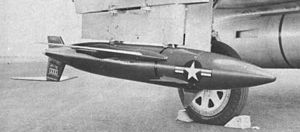- Northrop AQM-38
-
AQM-38 
AQM-38A on F-89 Scorpion launch aircraftType Target drone Place of origin  United States
United StatesService history In service 1959-1970s Used by United States military Production history Manufacturer Northrop Corporation Number built 2000+ Specifications (AQM-38A) Weight 300 pounds (140 kg) Length 9 feet 8 inches (2.95 m) Height 1 foot 6 inches (0.46 m) Diameter 12 inches (300 mm) Engine Aerojet 530NS35
36 lbf (160 N)Wingspan 5 feet (1.5 m) Propellant Solid fuel Flight ceiling 60,000 feet (18,000 m) Boost time 9 minutes Speed Mach 0.94 Launch
platformF-89 Scorpion The AQM-38 was an American target drone, developed by the Radioplane Division of the Northrop Corporation during the 1950s. Extensively used for surface-to-air missile training, over two thousand of the drones were built during its production run, with the missile continuing in use with the United States Army and United States Navy for almost twenty years.
Contents
Design and development
Following flight trials of the XKD4R target drone, developed for the United States Navy, Radioplane redesigned the aircraft into an improved version, designated RP-76, first flying in 1959.[1] Compared to the XKD4R, the RP-76 had redesigned wing fairings, with the vertical control fin being moved to the underside of the missile, as opposed to being on top.[2]
The RP-76 was designed to fly a pre-programmed trajectory on autopilot, with radio command guidance being optional.[1] As with the XKD4R, control was provided by three fins located forwards on the body of the craft. A Luneberg lens was included to augment the drone's radar signature, and recovery at the end of the flight was by parachute.[1]
Operational history
Flying for the first time in 1959,[2] the RP-76 was most often launched from a F-89 Scorpion fighter of the United States Air Force, and was extensively used by the U.S. Army for training the operators of surface-to-air missiles;[1] the drone was also used for training USAF fighter pilots in air-to-air gunnery.[3] A slightly modified version, designated RP-78, was supplied to the U.S. Navy; it used a more powerful rocket, producing 99,000 lbf (440 kN) of thrust,[3] to propel the drone to a top speed of Mach 1.25.[1]
In 1963 the RP-76 and RP-78 received the designations AQM-38A and AQM-38 in the new "tri-service" missile designation system.[3] In all, over 2000 examples of the drone were built by Northrop, with the missile remaining in service with the U.S. Military until the mid 1970s, when they were retired.[1]
See also
References
- Citations
- Bibliography
- Parsch, Andreas (2003a). "Northrop (Radioplane) AQM-38". Directory of U.S. Military Rockets and Missiles. designation-systems.net. http://www.designation-systems.net/dusrm/m-38.html. Retrieved 2011-01-28.
- Parsch, Andreas (2003b). "Radioplane KD4R". Directory of U.S. Military Rockets and Missiles Appendix 1: Early Missiles and Drones. designation-systems.net. http://www.designation-systems.net/dusrm/app1/kd4r.html. Retrieved 2011-01-28.
- Taylor, John W.R., ed (1967). Jane's All The World's Aircraft 1967-1968. London: Jane's Information Group.
United States Tri-service missile and drone designations post-19621–50 MGM-1 • RIM-2 • MIM-3 • AIM-4 • MGM-5 • RGM-6 • AIM-7 • RIM-8 • AIM-9 • CIM-10 • PGM-11 • AGM-12 • CGM-13/MGM-13 • MIM-14 • RGM-15 • CGM-16 • PGM-17 • MGM-18 • PGM-19 • ADM-20 • MGM-21 • AGM-22 • MIM-23 • RIM-24 • HGM-25 • AIM-26 • UGM-27 • AGM-28 • MGM-29 • LGM-30 • MGM-31 • MGM-32 • MQM-33 • AQM-34 • AQM-35 • MQM-36 • AQM-37 • AQM-38 • MQM-39 • MQM-40 • AQM-41 • MQM-42 • FIM-43 • UUM-44 • AGM-45 • MIM-46 • AIM-47 • AGM-48 • LIM-49 • RIM-50
51–100 MGM-51 • MGM-52 • AGM-53 • AIM-54 • RIM-55 • PQM-56 • MQM-57 • MQM-58 • RGM-59 • AQM-60 • MQM-61 • AGM-62 • AGM-63 • AGM-64 • AGM-65 • RIM-66 • RIM-67 • AIM-68 • AGM-69 • LEM-70 • BGM-71 • MIM-72 • UGM-73 • BQM-74/MQM-74 • BGM-75 • AGM-76 • FGM-77 • AGM-78 • AGM-79 • AGM-80 • AQM-81 • AIM-82 • AGM-83 • AGM-84/RGM-84/UGM-84 • RIM-85 • AGM-86 • AGM-87 • AGM-88 • UGM-89 • BQM-90 • AQM-91 • FIM-92 • XQM-93 • YQM-94 • AIM-95 • UGM-96 • AIM-97 • YQM-98 • LIM-99 • LIM-100
101–150 RIM-101 • PQM-102 • AQM-103 • MIM-104 • MQM-105 • BQM-106 • MQM-107 • BQM-108 • BGM-109 • BGM-110 • BQM-111 • AGM-112 • RIM-113 • AGM-114 • MIM-115 • RIM-116 • FQM-117 • LGM-118 • AGM-119 • AIM-120 • CQM-121 • AGM-122 • AGM-123 • AGM-124 • RUM-125/UUM-125 • BQM-126 • AQM-127 • AQM-128 • AGM-129 • AGM-130 • AGM-131 • AIM-132 • UGM-133 • MGM-134 • ASM-135 • AGM-136 • AGM-137 • CEM-138 • RUM-139 • MGM-140 • ADM-141 • AGM-142 • MQM-143 • ADM-144 • BQM-145 • MIM-146 • BQM-147 • FGM-148 • PQM-149 • PQM-150
151– See also: MA-31 • ASALM • Brazo • Have Dash • Wagtail
United States tri-service rocket designations post-1962Types of missile By platform Air-to-air missile (AAM) · Air-to-surface missile (ASM) · Surface-to-air missile (SAM) · Surface-to-surface missile (SSM) · Ballistic missile · Intercontinental ballistic missile (ICBM) · Submarine-launched ballistic missile (SLBM) · Anti-ballistic missile (ABM) · Intermediate-range ballistic missile (IRBM) · Cruise missile · Anti-ship missile (AShM) · Anti-submarine missile · Anti-tank missile (ATGM) · Anti-satellite weapon (ASAT) · Air-launched ballistic missile · Anti-ship ballistic missile (ASBM)By guidance Anti-radiation · Wire guidance · Infrared guidance · Beam riding · Laser guidance · Active radar guidance · Semi-active radar guidance · Unguided rocketsLists Categories:- Target drones
- Northrop aircraft
Wikimedia Foundation. 2010.
